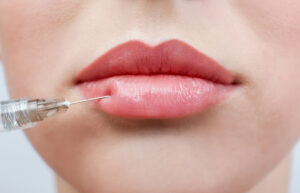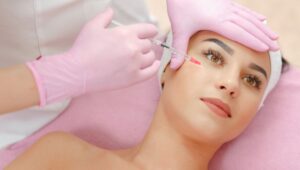How Botox Can Help Treat Various Forms of Sweating
Around the world, millions of individuals suffer from hyperhidrosis, or excessive sweating. Although not deadly, this condition can certainly lower one’s quality of life. Enter Botox: a purified protein, officially called botulinum toxin, that has a variety of medical and cosmetic applications. Our focus here is on how Botox can be used to alleviate different types of sweating, such as that caused by hyperhidrosis.
What is Botox and How Does it Treat Excessive Sweating (Hyperhidrosis)?
Hyperhidrosis, or excessive sweating, can be treated with Botox. But first, you might wonder: just what exactly is Botox? In simple terms, it’s a purified form of botulinum toxin, a protein that causes muscle paralysis. To treat hyperhidrosis, Botox is injected into the skin where sweat glands are located. This blocks the release of a chemical that triggers sweat production, reducing sweating in the treated area. The botulinum toxin, created by the bacteria Clostridium botulinum, is the key ingredient in Botox, a medication widely used for medical interventions. Medical applications for Botox are largely centered around its ability to cause a specific type of muscle paralysis, which can help with various concerns. One such application is in the treatment of excessive sweating. Rather than reducing sweating via physical or micrometric methods, Botox works differently by interfering with the chemical signals that normally trigger sweat gland activity. This ultimately and temporarily curbs the amount of sweat released.
What areas of the body can Botox be injected to treat excessive sweating?
Botox can be injected in various areas of the body to treat excessive sweating. These include the underarms, palms of the hands, soles of the feet, scalp, and even the face for wrinkles. The most common area for Botox injection to treat excessive sweating is the underarms, also known as axillary hyperhidrosis.
What is Hyperhidrosis?
Hyperhidrosis is a medical condition characterized by excessive sweating beyond what is necessary for thermoregulation. In other words, people with hyperhidrosis sweat excessively, even when the body doesn’t need to cool down. Hyperhidrosis can affect different areas of the body, including the underarms, palms of the hands, soles of the feet, and face.
What causes excessive sweating in Hyperhidrosis?
The exact cause of hyperhidrosis is not known, but it is thought to be a result of overactive sweat glands. In primary hyperhidrosis, the condition is not caused by an underlying medical condition or medication and is generally localized to one or more of the areas mentioned above. In secondary hyperhidrosis, excessive sweating is a symptom of an underlying medical condition or medication.
What are the treatments for Hyperhidrosis?
There is no cure for hyperhidrosis, but there are various treatment options available. These include over-the-counter antiperspirants, prescription antiperspirants, iontophoresis, oral medications, and even surgery in severe cases. One of the most effective treatments for hyperhidrosis is Botox injection.
How Effective is Botox in Treating Excessive Sweating?
How effective is Botox in treating excessive underarm sweat?
Botox has been shown to be highly effective in treating excessive underarm sweat. In clinical trials, 81% to 87% of patients experienced a significant reduction in sweating after Botox injections.
How effective is Botox in treating excessive sweating on other areas of the body?
Botox has also been shown to be effective in treating excessive sweating on other areas of the body, including the palms, feet, face, and scalp. However, the effectiveness of Botox in treating these areas may vary among individuals.
How long do the effects of Botox last in treating excessive sweating?
The effects of Botox in treating excessive sweating can last for several months, usually 6-12 months, but may last up to 14 months in some cases. After this period, repeat injections may be necessary to maintain the full effect.
How Botox Compares to Other Treatments for Excessive Sweating?
How does Botox compare to antiperspirants in treating excessive sweating?
Antiperspirants are an over-the-counter option for treating excessive sweating. Although they may be effective for mild cases of sweating, they may not work for more severe cases. Botox, on the other hand, has been shown to be highly effective in treating excessive sweating, especially in cases of axillary hyperhidrosis.
What are the advantages and disadvantages of Botox compared to other treatments for excessive sweating?
An advantage of Botox compared to other treatments for excessive sweating is that it is effective and has minimal side effects. Some of the disadvantages of Botox may include the cost of treatment and the need for repeat injections every few months. Additionally, Botox may cause muscle weakness and should only be administered by a qualified professional.
Can Botox be combined with other treatments for excessive sweating?
Botox can be combined with other treatments for excessive sweating, including antiperspirants, oral medications, and iontophoresis, to achieve optimal results. Your medical professional can determine the best treatment plan for your specific case.
What to Expect During a Botox Injection for Sweating?
Is the injection site painful during the Botox treatment for sweating?
The injection site may cause mild discomfort during the injection, but this usually only lasts for a few seconds. Your medical professional may use a topical anesthetic or ice to numb the area before injection to minimize discomfort.
What is the expected recovery time after Botox injection for excessive sweating?
There is no recovery time needed after Botox injection for excessive sweating, and patients can return to their daily activities immediately after treatment.
What are the possible side effects of Botox injection for sweating?
Possible side effects of Botox injection for sweating may include pain, redness, and swelling at the injection site, as well as muscle weakness in the treatment area. More serious side effects are rare but may include difficulty breathing, speaking, or swallowing, and should be reported immediately to your medical professional.
*Information in this article is not medical advice and may not be factually accurate. It is intended for entertainment purposes only. Consult with a physician before attempting any tips in this blog post and to get the most up to date factual data about any procedure or treatment.













